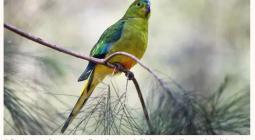Fifth of known species on Earth found in Unesco world heritage sites – survey

Sites cover less than 1% of planet and although protected are at risk from climate breakdown and human consumption, say experts
From the Great Barrier Reef to the Kazakh steppe, nearly three-quarters of all recorded bird species, two-thirds of all mammals and more than half of all hard corals have been recorded at world heritage sites even though they cover less than 1% of the planet, according to the new analysis produced by Unesco and the International Union for Conservation of Nature.
The 1,157 protected sites in almost every country on Earth, which include key nature sites such as the Okavango delta alongside landmarks such as the Great Wall of China, are home to some of the world’s most threatened species, including all remaining Javan rhinos, vaquita porpoises and pink iguanas, along with more than half of all mountain gorillas, breeding albatrosses and Sumatran orangutans.
Hyperion, the world’s tallest tree, standing at 115 metres, the stinking corpse lily, the largest flower, and the wintering region of the monarch butterfly are also found in the world heritage sites, according to the report. The survey found that together, the sites cover an area larger than India, including forests spanning twice the size of Germany.
But experts say the world heritage sites are threatened by climate breakdown and human overconsumption, prompting warnings that some species could go extinct in the protected areas despite being recognised as globally important.
The report authors say governments should think carefully about how better to protect the sites as they plan for meeting this decade’s UN biodiversity targets, which are due before biodiversity Cop16 next year, as part of their efforts to protect 30% of Earth and restore degraded ecosystems.
Lazare Eloundou Assomo, director of world heritage at Unesco, said that while most world heritage sites were cultural, they also included many important natural areas that must urgently get better protection.
“The main message is that we want governments to do more to protect these areas. World heritage sites are essential for the protection of biodiversity. We want them to do more by giving them the data to show that if they do not protect these areas, so many key species may go extinct. Vaquitas, the Javan rhinoceros, mountain gorillas: they are all in world heritage sites,” he said.
“We thought it was important to gather all the key scientific data and information concerning biodiversity at world heritage sites so people can see they are home to key species that could go extinct if the areas were not protected,” he added.
Other examples of unique biodiversity include Shark Bay in Australia, home to the largest seagrass plant on Earth, which stretches over 110 miles, and the 2,600-year-old Abuelo tree in Argentina.
The survey found that Unesco sites also cover vital migration routes such as the east Atlantic flyway for birds that stretches from the Arctic to South Africa and the east Asian-Australasian flyway. Routes for elephants, sharks and saiga antelope are also included, along with the great migration of wildebeest on the plains of east Africa.
To improve how sites are better protected, the report recommends that countries include Unesco sites in their national biodiversity strategies and action plans, which will detail how a country is contributing towards nature targets agreed at last December’s Cop15 biodiversity conference.
Photograph: Julia Thomsen - Flamingos in Everglades national park, Florida.





